The Intricate Balance of Qi and Blood in Traditional Chinese Medicine
In the human body, the quantity of qi and blood flowing through each meridian follows a consistent pattern. For instance, the Taiyang meridian often exhibits an abundance of blood but a deficiency of qi, while the Shaoyang meridian tends to show the opposite—an excess of qi and a dearth of blood. The Yangming meridian is generally abundant in both qi and blood, whereas the Shaoyin meridian usually has less blood and more qi. Meanwhile, the Jueyin meridian typically has more blood and less qi, and the Taiyin meridian frequently has an abundance of qi but a scarcity of blood. These characteristics are predetermined by our innate constitution.
The Bladder Meridian of Foot Taiyang and the Kidney Meridian of Foot Shaoyin are externally and internally connected, as are the Gallbladder Meridian of Foot Shaoyang and the Liver Meridian of Foot Jueyin. Likewise, the Stomach Meridian of Foot Yangming and the Spleen Meridian of Foot Taiyin share a similar relationship. These are the interconnected relationships between the three Yang meridians and three Yin meridians of the foot. The Small Intestine Meridian of Hand Taiyang and the Heart Meridian of Hand Shaoyin, the Triple Burner Meridian of Hand Shaoyang and the Pericardium Meridian of Hand Jueyin, and the Large Intestine Meridian of Hand Yangming and the Lung Meridian of Hand Taiyin exhibit comparable associations. This interconnectedness between the twelve meridians of the hands and feet, the Yin and Yang, is pivotal.
When diseases afflict a specific meridian, treatment begins by releasing excess blood if it is congested, thereby alleviating discomfort. Subsequently, the practitioner assesses the patient’s condition, addressing any deficiencies or excesses based on the specifics of the ailment.
To determine the locations of the five viscera’s back-shu points, start by measuring the distance between the nipples using a piece of straw. Fold this straw in half and, using another straw of equal length, cut the latter in half. This forms a triangle when the ends of the first straw are supported by the halves of the second. Align the top angle of this triangle with the Dazhui point (located at the base of the neck) on the patient’s back. The lower angles will point to the Lung-Shu points. Move the top angle down to the midpoint between the Lung-Shu points to locate the Heart-Shu points. Repeating this process identifies the Liver-Shu, Spleen-Shu, and Kidney-Shu points. This method establishes the precise locations for acupuncture and moxibustion.
Various conditions arise from different bodily and mental states. For those physically comfortable but mentally distressed, acupuncture is recommended. Those physically and mentally content often develop conditions in their muscles, treatable by needling or stone pressing. Individuals who are physically weary but mentally cheerful frequently encounter ailments in their tendons, best addressed by hot compresses or guided exercises. Physical and mental exhaustion often results in throat-related illnesses, for which medications are prescribed. Those repeatedly frightened suffer from disrupted qi, leading to numbness, treatable with massage and medicinal wine. These are the five types of diseases linked to physical and mental states.
For acupuncture:
- Yangming meridian: both blood and qi can be released.
- Taiyang meridian: only blood should be released, avoiding qi.
- Shaoyang meridian: only qi should be released, avoiding blood.
- Shaoyin meridian: only qi should be released, avoiding blood.
- Jueyin meridian: only blood should be released, avoiding qi.
